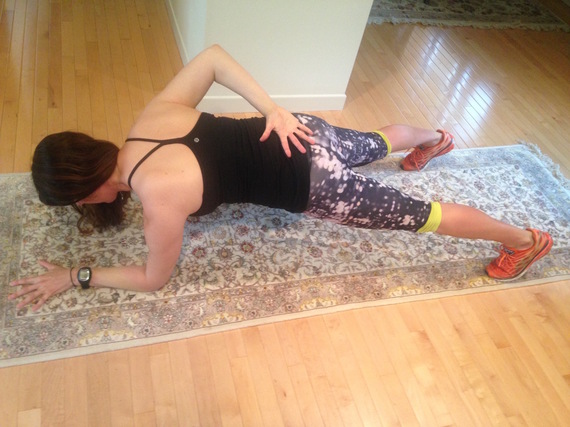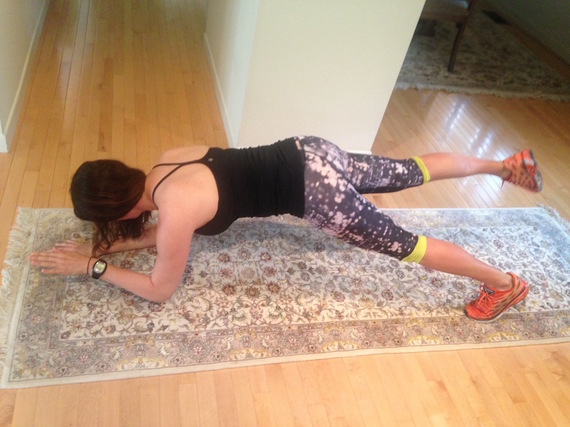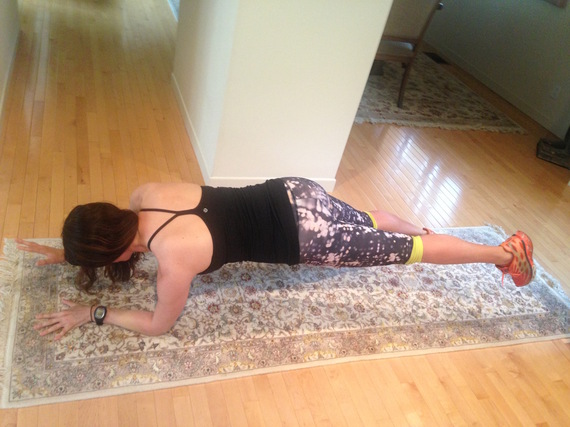Planking has become one of the most popular "core" exercise known in the fitness industry. And as many of you might have noticed, it requires a lot of upper body strength, especially in the shoulders, abdomen, back and arms. Let's be clear. The plank should actually utilize every muscle in the body, including the legs. Because this exercise requires one to suspend their body in mid air, and be supported by their toes and forearms (or hands), the trick to a good plank is to hold every muscle in an isometric contraction, including your lower extremity. The other trick to a good plank is to ensure your pelvis is in a neutral position (not tilted forward) so that you can also contract your "core" muscles including your obliques, transverse abdominis along with the diaphragm which we also need to use to breathe during this exercise. And get this; you need to figure out how to keep your diaphragm engaged for the exercise while using it to breathe. A lot of multi-tasking at its best.
Most planks are static, meaning, you just hang out in a basic plank. Not this plank. Instead, there is a dynamic component to it in that you will be timing the transitions and throwing your balance off within the basic plank format. There is a little bit of proprioception involved, or spatial awareness, so that you can train the brain while training the muscles. You must focus on breathing throughout the transitions and keeping the spine neutral the whole time. Keeping the spine neutral means not arching your lower back and not protracting your shoulders inward towards the ground.
According to physical therapist Dr. Mike Shapow, PhD, RPT of Joint Effort Wellness in Beverly Hills, "Attaining good core strength is preventative as well as curative for people with back and neck problems. Planks also help in creating muscle memory for good posture."
So while planks might be challenging to do, they certainly benefit you in more ways than not.
So are you ready to do this 3-minute plank challenge? Do it, time yourself and be open to getting better at it over time. Be patient with yourself. If you hold it for less than 3 minutes on your first attempt, just do it again another day. Practice is king! Once you've done it, consider introducing it to your loved ones, your peers, and everyone you know. Perhaps YOU start a trend on social media and challenge people to do this by sharing this link. Friendly challenges are always fun and give people a purpose to get more fit. Just a consideration.
This is the breakdown:
First Minute: Basic Plank
1:00-1:30: 15 seconds lift your right arm up, then your left arm for 15 seconds
1:30-2:00: 15 seconds lift your right foot off the ground, then your left foot for 15 seconds
2:00-2:30: 15 seconds lift your right foot and left arm off the ground, then your left foot and right arm off the ground for 15 seconds
2:30-3:00: Basic Plank
3:00: DONE
See the Video Demonstration HERE.
Directions for Execution:
Basic Plank: 
Position your shoulders over your elbows and balance on your toes. Tuck your pelvis under aiming your tailbone in between your legs. Contract your abdomen, but breathe. Keep your gaze down on the floor to neutralize the neck. Be sure to draw your shoulders down towards your back pockets so that your shoulders are away from your ears. Remember to contract every muscle in the body from head to toe. The more muscle recruitment, the stronger you will feel in this posture.
Arm Variations:
Without compromising form, widen your stance as much as you need to in order to keep the crests of your pelvis pointing down to the floor. Bring your right arm behind your back. You will feel the need to shift your hip so watch that you stabilize the hips and spine. Switch sides.
Leg Variation: 
Bring your legs together. Lift your right foot only inches off the ground. Tuck your pelvis. Relax your shoulders. Brace your abdomen and make sure you breathe. Switch sides.
Opposite Arm to Leg Variation:
The goal is to keep the basic plank formation with all muscles engaged. Once you "braced" your core muscles then lift your right hand inches off the ground along with your left foot. Stabilize this contralateral move. Your body will want to rotate so aim to have your hips squared to the ground as much as you can while keeping your chest facing the ground as well. After 15 seconds, switch sides.
The 3-minute plank variation instructional video can be seen HERE.
Photo and Video credits: Mr Smith